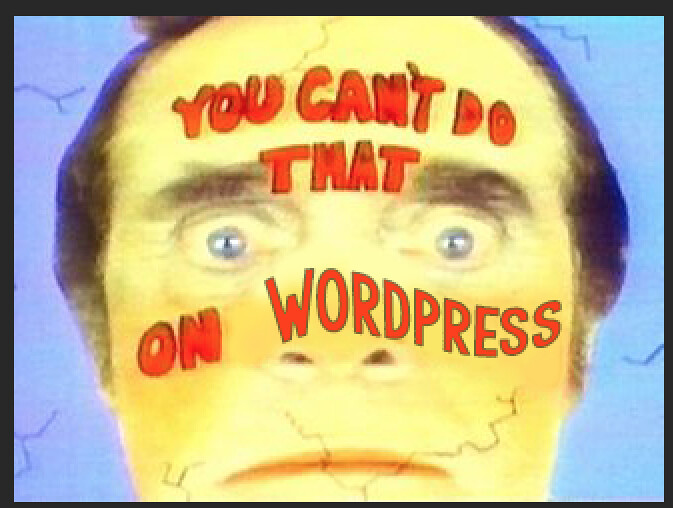I submitted something like this already to NMC but it failed . . . and I did not have a backup copy. They happened to extend the deadline so I’ve resubmitted and I’m sticking a copy here for future reference. It might also be useful just for a handy list of examples.
100 Word Summary
1
Open Source, highly flexible, and running 1 in every 4 sites on the Internet today, yet many still put WordPress in the “cat diary” box.2 In the initiative’s third year, we have 21,000+ sites. See examples of WordPress as a single-use tool and how it can be used to build truly customized courses. All examples are open to the world (no passwords). We’ll explore design patterns (build fast at scale) and powerful plugins (use the community). Mind expansion is the goal. The code’s on GitHub.
Warning: 1980s Canadian TV show references will occur.
These are all public examples. They’re in real courses in a large, public university. This is work that is accessible and possible for anyone.
Additionally, all the plugins and themes we create are on GitHub (here and here). I’ve also done my best to document how it all works on many posts on my site. I want people to be able to do this on their own or with their institution and will focus on those possibilities.
Tools
We’ll look at how to streamline WordPress so that it’ll do that one thing. These are various sites which structure student input towards creating a specific item and creating a larger valuable resource. Examples include-
- Blackout Poetry – Art and English – blackout poetry creator for a mindfulness course
- Sociology Resources – an early example of a student submitted resource site for Sociology
- East End Cemetery – Sociology and History site to catalog grave markers at an African-American graveyard (student submitted) – cell phone focused submissions
- Psychology 795 paper reviews – Psychology site of student-reviewed papers
- Urban Bicycle Survey Map – Urban Planning student submitted site around bicycle safety – cell phone focused submissions with GIS data (alternate display using new WP REST API)
- AFAM 491 Race and Space – student submitted images and narrative
- Text Sets – School of Ed students submitting unit text sets (an early example that has issues worth pointing out)
- SPAN202 Media – Students find and use ‘press this’ to contribute interesting target language media to a central site. That content is then used to build larger lessons by faculty. We’re doing this across all our languages. Here’s a Russian example. (starting Arabic next semester).
- Field Botany dichotomous key – Not digital humanities but a valuable example of user experience options – cell phone focused submissions
Courses
What makes WordPress really different from the LMS is when it embodies the professor and the discipline. Customizing is a lot more than changing the header image. It also has the potential to change how you think about teaching the class and how students interact with the content (in f2f, blended, or fully-online course)
These examples are built quickly (usually in hours, occasionally a few weeks) and often revised with students in them. Not optimal but functional and development time doesn’t become the purgatory.
- RVArts – Arts students create a cultural calendar and review events as a course (John Freyer)
- Artfulness – University-wide wellness + art site that is also a course (Molly Ransone)
- Digital History – Evolving site that randomize map coordinates on each load and interweaves Google Drive elements while using lots of CC licensed historical photos (Ryan Smith)
- Socially Engaged Media – Arts course embodying the professor’s eclectic approach – operations, makers, horsies. (Bob Paris)
- Austria 2016 – Parallel German and photography study-abroad courses. Content is then used in German courses. (Jessica Lonnes)
- ICA Museum course – built to resemble the ICA museum site. This site was customized in ~1 hr. (Chioke Ianson)
- Sociological Theory – An undergraduate and graduate sociology course blended and organized by the sociologist rather than the assignment (Jennifer Johnson)
- Thought Vectors – Multiple first-year writing/critical-thinking courses with a focus on how technology impacts how we think. (Gardner Campbell, Jessica Gordon, Bonnie Boaz, Ryan Cales, Jason Coates, Jon Becker)
- ANTH101 – Powerful example of a course that is face-to-face and online and which weaves together student work in powerful ways. (Mike Wesch, Ryan Klatske – Kansas State)


That’s an impressive portfolio.
If you are going to Boston, you can score $120 from me (1)
Also, FYI, the cat diaries are ALIVE (2)
Can I haz footnotes in comments?
(1) http://cogdogblog.com/2015/03/dialed-back-to-1982/
(2) http://cat-diaries.blogspot.com/